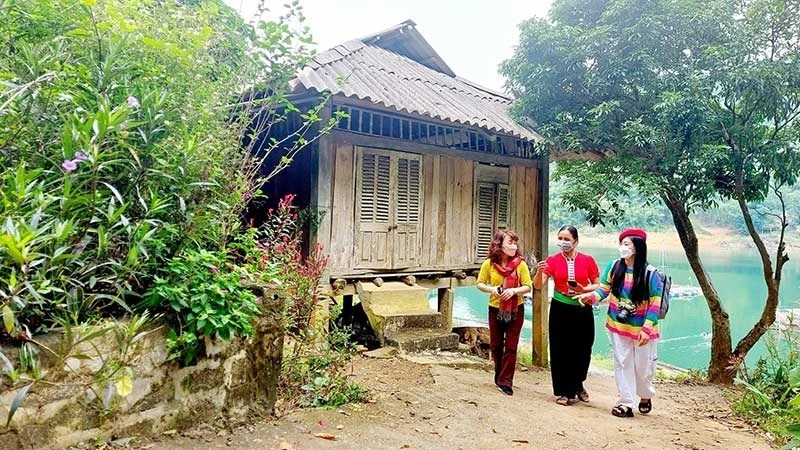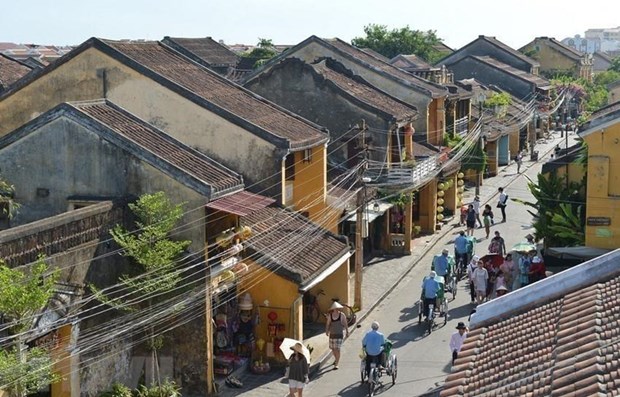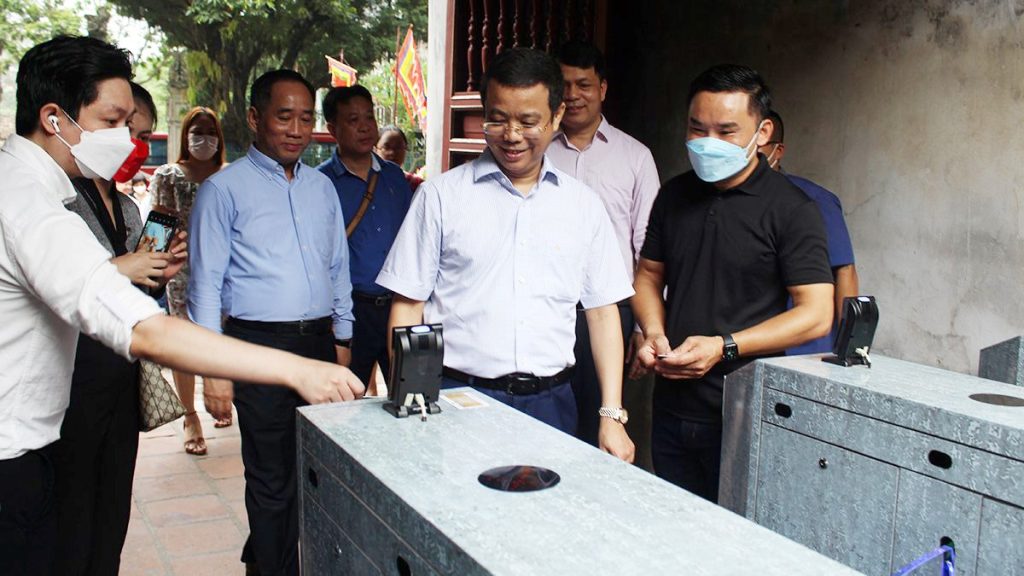With the diverse potential of natural landscapes, historical traditions and indigenous cultures of 54 ethnic groups, Vietnam possesses great strengths in community-based tourism. This is also one of the main tourism types that needs to be promoted in Vietnam’s Tourism Development Strategy until 2030.

The locals guide tourists to visit Da Bia Village (Da Bac District, Hoa Binh Province). (Photo: Mai Mai)
Community-based tourism can be understood as a tourism model, in which the community is the subject of providing products and services to tourists and sharing the benefits brought by tourism.
Through activities to serve tourists, such as accommodation, dining, experiencing local culture and selling local souvenirs, community-based tourism not only creates unique and attractive tourism products, meeting the increasing needs of tourists but also contributes to preserving and promoting unique local cultural values, protecting resources and tourism environments, while creating livelihoods to increase people’s income.
In recent years, community-based tourism has been increasingly expanded across the country with many successful development models, to help change the lives of communities such as Ha Giang, Hoa Binh, Lai Chau and Lang Son in the northern mountainous area; Nghe An, Thua Thien Hue, Quang Nam and Lam Dong in the Central Highlands and central region; and Dong Thap, An Giang, Long An and Vinh Long in the southern region.
Especially, community-based tourism models in Da Bia community village (in Hoa Binh Province), Thai Hai Conservation Area for Ecological House on Stilt Village in Thai Nguyen Province, Sin Suoi Ho Community Tourism Village in Lai Chau Province and Tan Thanh Fishing Village Tourism Community in Quang Nam Province, were honoured by the ASEAN Community Tourism Awards. These are all “magnets” that are attracting a large number of domestic and international tourists to experience.
However, many experts said after nearly 30 years since its appearance in Vietnam, community-based tourism in some places still has certain limitations.
According to statistics from the Vietnam National Authority of Tourism, it was estimated that there were about 300 villages and hamlets providing community tourism activities, with more than 5,000 homestays across the country, but just over 2,000 establishments were recognised as meeting tourist service standards.
Talking at a dialogue on community-based tourism, recently conducted by the Investment Newspaper, Vice Chairman of Vietnam Community-based Tourism Chapter (VCTC) and Director of Vietnam Travelogy Company Vu Van Tuyen stressed that normally, it is necessary to study the market, the behaviour of tourists and their wishes when travelling, to develop a suitable tourism product, based on the unit’s strengths for customers. However, many community-based tourism products go against that rule.
Nguyen Ngoc Bich, Chairman of the Board of Directors of Rustic Hospitality Group Company and Creative Director of the Swiss Tourism for Sustainable Development Project said, that community-based tourism models in many parts of the country are operating without any consulting, management or quality monitoring units, leading to over-exploitation of natural and cultural resources. For example, when they see increased tourist demand, they are ready to build more accommodation areas, disrupt the natural landscape, and commercialise indigenous culture, causing damage and seriously affecting sustainable development.
From the reality of researching and supporting villages and hamlets to develop community-based tourism, Vu Van Tuyen spoke about the development of tourism in Na Su Village, in Dien Bien Province. “This is a poor village that is located quite far from the city centre but still retains its indigenous cultural features when welcoming tourists. Notably, this is also one of the first community tourism destinations that have strongly and methodically applied 4.0 technology to tourist service activities. QR codes are posted at village gates and house doors for tourists to easily access and learn about outstanding cultural and historical features. Audio guide applications and tourist maps are also put into use towards increasing the ability to interact with tourists”, he said.
Tuyen noted that over the past years, the Party and State have issued many policies and regulations related to community-based tourism development. However, it is crucial to make more specific and methodical guidance for regions and localities.
Localities need to have specialised human resources to directly work with the locals, to guide and support them on related issues. To develop sustainable community-based tourism, it is necessary to have specific orientation and planning.
State management agencies, businesses and representatives of the tourism community need to conduct thorough surveys and research on the destination’s ability for community-based tourism development, thereby determining appropriate exploitation directions and providing a specific model. The model in the coastal region will be different from the mountainous region, even those in the mountainous region must also be different from the Northwest and Northeast.
From the perspective of a business, Nguyen Ngoc Bich said the community-based tourism model in many places has been positioned to serve tourists with low payment rates and people’s income mainly comes from the provision of food and accommodation services at cheap prices, so the revenues are not high.
Meanwhile, tourists today have a great demand for travel experiences and are willing to pay for high-end services of community-based tourism. Thereby, instead of just exploiting their own houses, fields and gardens, homestay owners need to combine with businesses to attract guests and exploit community cultural experience, based on harmonious distribution of benefits. That is the way to preserve and spread local culture, while sustainably developing community-based tourism.
Viet Anh – Translated by NDO
NDO – en.nhandan.vn – September 30, 2023




